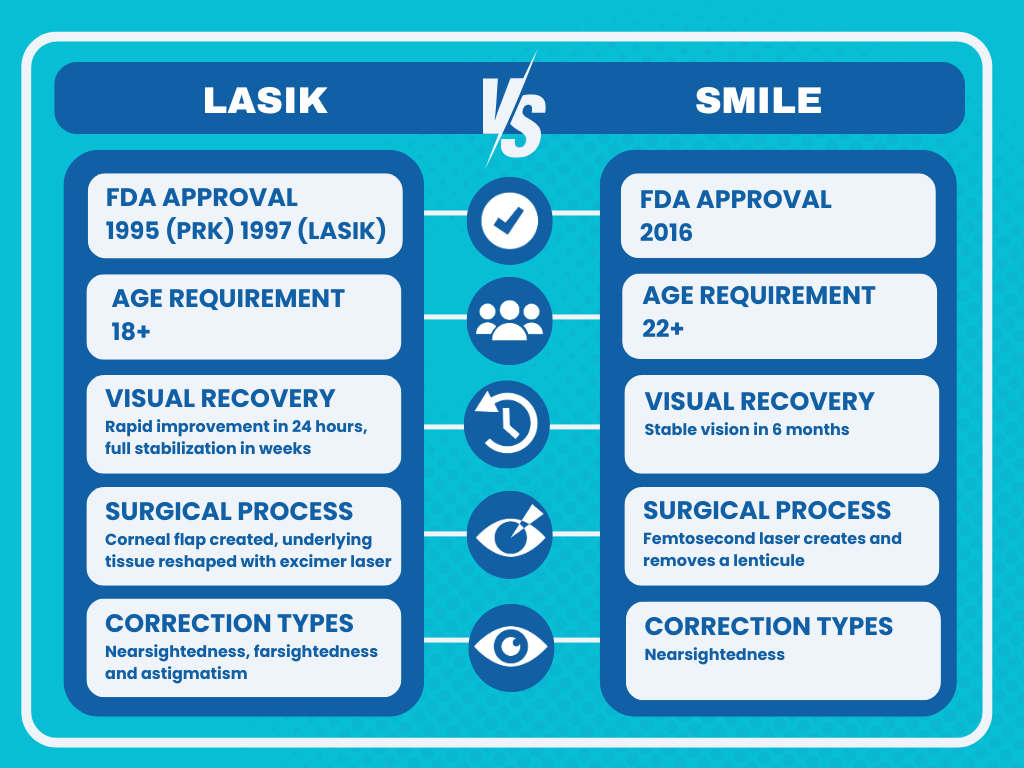In the realm of vision correction procedures, two prominent contenders stand out: Smile Vision Correction and LASIK. These advanced techniques have revolutionized the field of ophthalmology, offering patients improved vision and quality of life. However, deciding between Smile Vision Correction and LASIK can be daunting without a comprehensive understanding of each procedure’s nuances, benefits, and considerations. In this article, I will delve deep into the intricacies of Smile Vision Correction and LASIK to help you make an informed decision about which option aligns best with your vision goals.
Introducing Smile Vision Correction
Understanding the Procedure
Smile Vision Correction, short for Small Incision Lenticule Extraction, is one of the latest refractive surgery techniques designed to correct myopia (nearsightedness) and astigmatism. Unlike traditional LASIK, which a corneal flap needs to be created, before a laser reshapes the cornea, Smile Vision Correction involves the creation of a small, precise incision within the cornea to extract a lenticule, thereby altering its shape and correcting the refractive error.
Advantages of Smile Vision Correction
Minimally Invasive Approach
One of the key advantages of Smile Vision Correction is its minimally invasive nature. By requiring only a small incision, this procedure preserves more of the corneal structure. Visual recovery, however, tends to take longer and recent studies indicate that , such as Dry Eye Syndrome are similar to LASIK
Comfort and Stability
Patients undergoing Smile Vision Correction often report minimal discomfort during and after the procedure, similar to LASIK.
Suitable for Thin Corneas
Individuals with thin corneas, who may not be suitable candidates for traditional LASIK, may find Smile Vision Correction to be a viable alternative due to its minimal impact on corneal thickness.

Considerations and Limitations
While Smile Vision Correction offers numerous benefits, it may not be suitable for all patients. Factors such as the severity of refractive error, corneal thickness, and ocular health must be carefully evaluated to determine candidacy for this procedure. Additionally, the availability of Smile Vision Correction may vary depending on geographic location and the expertise of ophthalmic surgeons.
Exploring LASIK
Overview of the Procedure
LASIK, or Laser-Assisted In Situ Keratomileusis, remains the most widely performed refractive surgery worldwide. During LASIK surgery, a specialized laser is used to create a thin flap in the outer layer of the cornea, allowing for precise reshaping of the underlying tissue to correct refractive errors such as myopia, hyperopia, and astigmatism.
Advantages of LASIK
Rapid Visual Recovery
One of the primary advantages of LASIK is its rapid visual recovery time. Many patients experience significant improvement in vision within hours of the procedure, with optimal results typically achieved within a few days.
Versatility and Customization
LASIK offers exceptional versatility, allowing surgeons to tailor the procedure to each patient’s unique visual needs. Advanced technologies such as wavefront-guided and topography-guided LASIK further enhance precision and customization, optimizing visual outcomes.
Established Track Record
With decades of clinical research and refinement, LASIK has established itself as a safe and effective option for vision correction. The widespread adoption of LASIK worldwide is a testament to its reliability and patient satisfaction rates.
Considerations and Limitations
While LASIK is highly effective for the majority of patients, certain considerations and limitations should be taken into account. Factors such as age, ocular health, and lifestyle may influence candidacy for LASIK. Additionally, as with any surgical procedure, there are potential risks and complications, including dry eye, glare, halos, and under correction or overcorrection of refractive error.
SMILE vs. LASIK: Comparison
When considering vision correction, SMILE and LASIK are two popular options. Here’s a quick comparison:

Making an Informed Decision
Factors to Consider
When weighing the options between Smile Vision Correction and LASIK, several factors should be considered:
- Refractive Error: The type and severity of your refractive error will influence which procedure is most suitable for you.
- Corneal Thickness: Patients with thin corneas may benefit from Smile Vision Correction, while LASIK may be preferred for those with thicker corneas.
- Ocular Health: Pre-existing eye conditions or abnormalities may impact candidacy for either procedure.
- Personal Preferences: Factors such as recovery time, discomfort during the procedure, and long-term stability may vary between Smile Vision Correction and LASIK, so it’s essential to prioritize your personal preferences and goals.
Our Commitment to Patient Care
At the Whiting Clinic, we prioritize patient safety and satisfaction. Before offering new technologies, we ensure they have a proven safety record. While SMILE is a less invasive procedure than LASIK, its long-term data is limited. Therefore, we currently specialize in LASIK, a well-established and effective procedure.
If you’re interested in SMILE, discuss it with your eye doctor. They can provide detailed information about its potential benefits and risks to help you make an informed decision.
Both SMILE Vision Correction and LASIK are excellent options for achieving clear vision and reducing reliance on glasses or contact lenses. Understanding the differences between these procedures and considering your unique needs will help ensure the best outcome and improved quality of life.
Sources
What Is Small Incision Lenticule Extraction? (2023, May 17). American Academy of Ophthalmology. https://www.aao.org/eye-health/treatments/what-is-small-incision-lenticule-extraction
Categories




